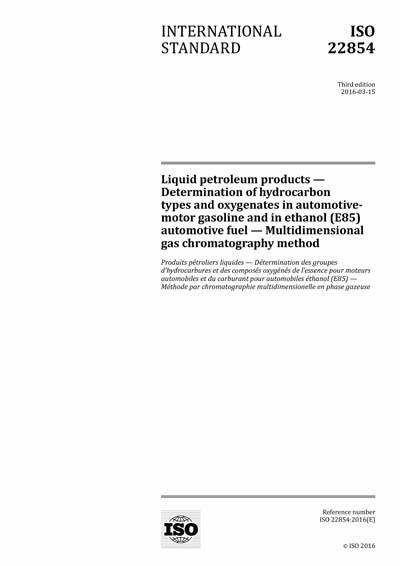Historical
ISO 22854:2016
Liquid petroleum products - Determination of hydrocarbon types and oxygenates in automotive-motor gasoline and in ethanol (E85) automotive fuel - Multidimensional gas chromatography method
ISO 22854:2016 specifies the gas chromatographic (GC) method for the determination of saturated, olefinic and aromatic hydrocarbons in automotive motor gasoline and ethanol (E85) automotive fuel. Additionally, the benzene content, oxygenate compounds and the total oxygen content can be determined.
NOTE 1 For the purposes of this document, the terms % (m/m) and % (V/V) are used to represent respectively the mass fraction, µ, and the volume fraction, φ.
ISO 22854:2016 defines two procedures, A and B.
Procedure A is applicable to automotive motor gasoline with total aromatics of up to 50 % (V/V); total olefins from about 1,5 % (V/V) up to 30 % (V/V); oxygenates from 0,8 % (V/V) up to 15 % (V/V); total oxygen from about 1,5 % (m/m) to about 3,7 % (m/m); and benzene of up to 2 % (V/V). The system can be used for ethers with 5 or more C atoms up to 22 % (V/V) but the precision has not been established up to this level.
Although this test method can be used to determine higher-olefin contents of up to 50 % (V/V), the precision for olefins was tested only in the range from about 1,5 % (V/V) to about 30 % (V/V).
Although specifically developed for the analysis of automotive motor gasoline that contains oxygenates, this test method can also be applied to other hydrocarbon streams having similar boiling ranges, such as naphthas and reformates.
NOTE 2 For Procedure A, precision data have been established for the oxygenate compounds in automotive motor gasoline samples containing ethyl-tert-butyl ether (ETBE), methyl-tert-butyl ether (MTBE), tert-amyl-methyl ether (TAME), iso-propanol, iso-butanol, tert-butanol, methanol and ethanol. The derived precision data for methanol do not comply with the precision calculation as presented in this International Standard. Applicability of this International Standard has also been verified for the determination of n-propanol, acetone, and di-isopropyl ether (DIPE). However, no precision data have been determined for these compounds.
Procedure B describes the procedure for the analysis of oxygenated groups (ethanol, methanol, ethers, C3 ? C5 alcohols) in ethanol (E85) automotive fuel containing ethanol between 50 % (V/V) and 85 % (V/V). The gasoline is diluted with an oxygenate-free component to lower the ethanol content to a value below 20 % (V/V) before the analysis by GC. If the ethanol content is unknown, it is advisable to use a dilution of 4:1 when analysing the sample.
The sample can be fully analysed including hydrocarbons. Precision data for the diluted sample are only available for the oxygenated groups.
NOTE 3 For Procedure B, the precision can be used for an ethanol fraction from about 50 % (V/V) up to 85 % (V/V). For the ether fraction, the precision as specified in Table 6 can be used for samples containing at least 11 % (V/V) of ethers. For the higher alcohol fraction, too few data were obtained to derive a full precision statement and the data presented in Table 6 are therefore only indicative.
NOTE 4 While developing this test method, the final boiling point was limited to 215 °C.
NOTE 5 An overlap between C9 and C10 aromatics can occur. However, the total is accurate. Isopropyl benzene is resolved from the C8 aromatics and is included with the other C9 aromatics.
International Organization for Standardization [iso]

